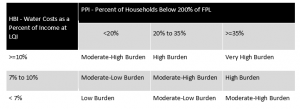Global S&T Development Trend Analysis Platform of Resources and Environment
| Water Experts Recommend New Methods to Measure Rate Affordability, Financial Capabilities | ||
| admin | ||
| 2020-02-28 | ||
| 发布年 | 2020 | |
| 语种 | 英语 | |
| 国家 | 国际 | |
| 领域 | 资源环境 | |
| 正文(英文) | Water, wastewater, and stormwater bills have been increasing above general price inflation and household income growth rates for decades. Affordability, therefore, has become an increasingly important issue, heightening focus on utility rate design, customer service policies, and customer assistance programs. It’s time to revisit traditional methods of measuring household affordability and assessing community financial capability. The U.S. Environmental Protection Agency (EPA) currently approaches Financial Capability Assessments (FCAs) of water customers through a simple methodology: costs as a percent of Median Household Income (MHI) and an index of various metrics of community financial strength. Aiming for more site-specific FCA guidelines, the Water Environment Federation (WEF; Alexandria, Va.), the American Water Works Association (AWWA; Denver, Colo.), and the National Association of Clean Water Agencies (NACWA; Washington, D.C.) are recommending new methodologies for assessing household affordability and community financial capability.
Recommended Household Affordability MetricsThe organizations’ recommended metrics for gauging household affordability hinge on easily accessible, reliable, and available data. Most importantly, the metrics are designed to:
Based on these criteria, the organizations recommended EPA consider the following combination of household affordability measures as an alternative to EPA’s current residential indicator (RI):
Recommended FCA MethodsThe organizations recommend the use of cash-flow forecasting to gauge financial capabilities and define schedules for capital improvement program implementation. A centerpiece concept of the new methodology is calling upon folks to use cash-flow modeling with defined rate slopes to determine the year-over-year financial capacity to fund required improvements. These rate increase forecasts may then be used to assess prospective financial burdens using the new recommended Household Affordability metrics outlined above.  Rate-setters can interpret both the household burden indicator and poverty prevalence indicator using this matrix, which uses a set of benchmarks to differentiate between what policymakers and stakeholders may consider to be relatively affordable, as contrasted to water costs that may be considered potentially or clearly unaffordable. For FCA purposes, a viable financial plan balances sensible, affordable utility rates with cost-effective financing of required system improvements. A reasonable increase in utility rates over time (i.e. rate slope), and the resulting household utility bill effectively defines the annual funding constraints within which required system improvements may be funded, and in the consent-decree context, would be negotiated by the utility and EPA. Projects whose funding may exceed annual budget constraints and HBI thresholds must be deferred and rescheduled to conform to the entity’s financial limitations. Keeping Rates ReasonableUtilities may consider a number of measures and metrics to gauge what might be deemed a reasonable rate increase slope, including forecasts of:
Utilities should also consider basic economic fundamentals. For example, there should be some expectation that rates will increase at least in alignment with general price or income inflation, and that non-compliant utilities may not preserve rate levels below their peer utilities, unless socioeconomic factors justify lower rates in their community. Negotiated rate slopes should enable orderly ratepayer budgeting and not impose an undue drag on regional growth, particularly in communities facing economic disadvantage. Guided by these basic principles, utilities can develop cash-flow forecasts that incorporate rate increase programs that appropriately reflect a utility’s financial capabilities. With an acceptable rate slope established, scheduling of system improvements is largely a matter of determining which regulatory compliance projects and programs should be prioritized and sequenced for financing within the defined annual affordability constraints. The recommendation to pair cash-flow forecasts assessing financial capabilities with references to new measures of household affordability will better guide Clean Water Act enforcement (particularly scheduling of compliance programs) and allow EPA to apply greater focus on advancing equity and financial sustainability. Read the full report, “Developing a New Framework for Household Affordability and Financial Capability Assessment in the Water Sector,” on the WEF website. — Eric P. Rothstein, Galardi Rothstein Group | |
| URL | 查看原文 | |
| 来源平台 | Water Environment Federation | |
| 文献类型 | 新闻 | |
| 条目标识符 | http://119.78.100.173/C666/handle/2XK7JSWQ/229253 | |
| 专题 | 资源环境科学 | |
| 推荐引用方式 GB/T 7714 | admin. Water Experts Recommend New Methods to Measure Rate Affordability, Financial Capabilities. 2020. |
| 条目包含的文件 | 条目无相关文件。 | |||||
| 个性服务 |
| 推荐该条目 |
| 保存到收藏夹 |
| 查看访问统计 |
| 导出为Endnote文件 |
| 谷歌学术 |
| 谷歌学术中相似的文章 |
| [admin]的文章 |
| 百度学术 |
| 百度学术中相似的文章 |
| [admin]的文章 |
| 必应学术 |
| 必应学术中相似的文章 |
| [admin]的文章 |
| 相关权益政策 |
| 暂无数据 |
| 收藏/分享 |
除非特别说明,本系统中所有内容都受版权保护,并保留所有权利。
修改评论